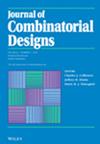Gyula O. H. Katona, Gyula Y. Katona
求助PDF
{"title":"关于一个附加条件的Baranyai定理","authors":"Gyula O. H. Katona, Gyula Y. Katona","doi":"10.1002/jcd.21992","DOIUrl":null,"url":null,"abstract":"<div>\n \n <p>A <span></span><math>\n <semantics>\n <mrow>\n \n <mrow>\n <mrow>\n <mo>(</mo>\n \n <mrow>\n <mi>k</mi>\n \n <mo>,</mo>\n \n <mi>ℓ</mi>\n </mrow>\n \n <mo>)</mo>\n </mrow>\n </mrow>\n </mrow>\n </semantics></math> partial partition of an <span></span><math>\n <semantics>\n <mrow>\n \n <mrow>\n <mi>n</mi>\n </mrow>\n </mrow>\n </semantics></math>-element set is a collection of <span></span><math>\n <semantics>\n <mrow>\n \n <mrow>\n <mi>ℓ</mi>\n </mrow>\n </mrow>\n </semantics></math> pairwise disjoint <span></span><math>\n <semantics>\n <mrow>\n \n <mrow>\n <mi>k</mi>\n </mrow>\n </mrow>\n </semantics></math>-element subsets. It is proved that, if <span></span><math>\n <semantics>\n <mrow>\n \n <mrow>\n <mi>n</mi>\n </mrow>\n </mrow>\n </semantics></math> is large enough, one can find <span></span><math>\n <semantics>\n <mrow>\n \n <mrow>\n <mfenced>\n <mrow>\n <mfenced>\n <mfrac>\n <mi>n</mi>\n \n <mi>k</mi>\n </mfrac>\n </mfenced>\n \n <mo>∕</mo>\n \n <mi>ℓ</mi>\n </mrow>\n </mfenced>\n </mrow>\n </mrow>\n </semantics></math> such partial partitions in such a way that if <span></span><math>\n <semantics>\n <mrow>\n \n <mrow>\n <msub>\n <mi>A</mi>\n \n <mn>1</mn>\n </msub>\n </mrow>\n </mrow>\n </semantics></math> and <span></span><math>\n <semantics>\n <mrow>\n \n <mrow>\n <msub>\n <mi>A</mi>\n \n <mn>2</mn>\n </msub>\n </mrow>\n </mrow>\n </semantics></math> are distinct classes in one of the partial partitions, <span></span><math>\n <semantics>\n <mrow>\n \n <mrow>\n <msub>\n <mi>B</mi>\n \n <mn>1</mn>\n </msub>\n </mrow>\n </mrow>\n </semantics></math> and <span></span><math>\n <semantics>\n <mrow>\n \n <mrow>\n <msub>\n <mi>B</mi>\n \n <mn>2</mn>\n </msub>\n </mrow>\n </mrow>\n </semantics></math> are distinct classes in another one, then one of the intersections <span></span><math>\n <semantics>\n <mrow>\n \n <mrow>\n <msub>\n <mi>A</mi>\n \n <mn>1</mn>\n </msub>\n \n <mo>∩</mo>\n \n <msub>\n <mi>B</mi>\n \n <mn>1</mn>\n </msub>\n \n <mo>,</mo>\n \n <msub>\n <mi>A</mi>\n \n <mn>2</mn>\n </msub>\n \n <mo>∩</mo>\n \n <msub>\n <mi>B</mi>\n \n <mn>2</mn>\n </msub>\n </mrow>\n </mrow>\n </semantics></math> has size at most <span></span><math>\n <semantics>\n <mrow>\n \n <mrow>\n <mfrac>\n <mi>k</mi>\n \n <mn>2</mn>\n </mfrac>\n </mrow>\n </mrow>\n </semantics></math>.</p>\n </div>","PeriodicalId":15389,"journal":{"name":"Journal of Combinatorial Designs","volume":"33 9","pages":"373-376"},"PeriodicalIF":0.8000,"publicationDate":"2025-06-16","publicationTypes":"Journal Article","fieldsOfStudy":null,"isOpenAccess":false,"openAccessPdf":"","citationCount":"0","resultStr":"{\"title\":\"Toward a Baranyai Theorem With an Additional Condition\",\"authors\":\"Gyula O. H. Katona, Gyula Y. Katona\",\"doi\":\"10.1002/jcd.21992\",\"DOIUrl\":null,\"url\":null,\"abstract\":\"<div>\\n \\n <p>A <span></span><math>\\n <semantics>\\n <mrow>\\n \\n <mrow>\\n <mrow>\\n <mo>(</mo>\\n \\n <mrow>\\n <mi>k</mi>\\n \\n <mo>,</mo>\\n \\n <mi>ℓ</mi>\\n </mrow>\\n \\n <mo>)</mo>\\n </mrow>\\n </mrow>\\n </mrow>\\n </semantics></math> partial partition of an <span></span><math>\\n <semantics>\\n <mrow>\\n \\n <mrow>\\n <mi>n</mi>\\n </mrow>\\n </mrow>\\n </semantics></math>-element set is a collection of <span></span><math>\\n <semantics>\\n <mrow>\\n \\n <mrow>\\n <mi>ℓ</mi>\\n </mrow>\\n </mrow>\\n </semantics></math> pairwise disjoint <span></span><math>\\n <semantics>\\n <mrow>\\n \\n <mrow>\\n <mi>k</mi>\\n </mrow>\\n </mrow>\\n </semantics></math>-element subsets. It is proved that, if <span></span><math>\\n <semantics>\\n <mrow>\\n \\n <mrow>\\n <mi>n</mi>\\n </mrow>\\n </mrow>\\n </semantics></math> is large enough, one can find <span></span><math>\\n <semantics>\\n <mrow>\\n \\n <mrow>\\n <mfenced>\\n <mrow>\\n <mfenced>\\n <mfrac>\\n <mi>n</mi>\\n \\n <mi>k</mi>\\n </mfrac>\\n </mfenced>\\n \\n <mo>∕</mo>\\n \\n <mi>ℓ</mi>\\n </mrow>\\n </mfenced>\\n </mrow>\\n </mrow>\\n </semantics></math> such partial partitions in such a way that if <span></span><math>\\n <semantics>\\n <mrow>\\n \\n <mrow>\\n <msub>\\n <mi>A</mi>\\n \\n <mn>1</mn>\\n </msub>\\n </mrow>\\n </mrow>\\n </semantics></math> and <span></span><math>\\n <semantics>\\n <mrow>\\n \\n <mrow>\\n <msub>\\n <mi>A</mi>\\n \\n <mn>2</mn>\\n </msub>\\n </mrow>\\n </mrow>\\n </semantics></math> are distinct classes in one of the partial partitions, <span></span><math>\\n <semantics>\\n <mrow>\\n \\n <mrow>\\n <msub>\\n <mi>B</mi>\\n \\n <mn>1</mn>\\n </msub>\\n </mrow>\\n </mrow>\\n </semantics></math> and <span></span><math>\\n <semantics>\\n <mrow>\\n \\n <mrow>\\n <msub>\\n <mi>B</mi>\\n \\n <mn>2</mn>\\n </msub>\\n </mrow>\\n </mrow>\\n </semantics></math> are distinct classes in another one, then one of the intersections <span></span><math>\\n <semantics>\\n <mrow>\\n \\n <mrow>\\n <msub>\\n <mi>A</mi>\\n \\n <mn>1</mn>\\n </msub>\\n \\n <mo>∩</mo>\\n \\n <msub>\\n <mi>B</mi>\\n \\n <mn>1</mn>\\n </msub>\\n \\n <mo>,</mo>\\n \\n <msub>\\n <mi>A</mi>\\n \\n <mn>2</mn>\\n </msub>\\n \\n <mo>∩</mo>\\n \\n <msub>\\n <mi>B</mi>\\n \\n <mn>2</mn>\\n </msub>\\n </mrow>\\n </mrow>\\n </semantics></math> has size at most <span></span><math>\\n <semantics>\\n <mrow>\\n \\n <mrow>\\n <mfrac>\\n <mi>k</mi>\\n \\n <mn>2</mn>\\n </mfrac>\\n </mrow>\\n </mrow>\\n </semantics></math>.</p>\\n </div>\",\"PeriodicalId\":15389,\"journal\":{\"name\":\"Journal of Combinatorial Designs\",\"volume\":\"33 9\",\"pages\":\"373-376\"},\"PeriodicalIF\":0.8000,\"publicationDate\":\"2025-06-16\",\"publicationTypes\":\"Journal Article\",\"fieldsOfStudy\":null,\"isOpenAccess\":false,\"openAccessPdf\":\"\",\"citationCount\":\"0\",\"resultStr\":null,\"platform\":\"Semanticscholar\",\"paperid\":null,\"PeriodicalName\":\"Journal of Combinatorial Designs\",\"FirstCategoryId\":\"100\",\"ListUrlMain\":\"https://onlinelibrary.wiley.com/doi/10.1002/jcd.21992\",\"RegionNum\":4,\"RegionCategory\":\"数学\",\"ArticlePicture\":[],\"TitleCN\":null,\"AbstractTextCN\":null,\"PMCID\":null,\"EPubDate\":\"\",\"PubModel\":\"\",\"JCR\":\"Q3\",\"JCRName\":\"MATHEMATICS\",\"Score\":null,\"Total\":0}","platform":"Semanticscholar","paperid":null,"PeriodicalName":"Journal of Combinatorial Designs","FirstCategoryId":"100","ListUrlMain":"https://onlinelibrary.wiley.com/doi/10.1002/jcd.21992","RegionNum":4,"RegionCategory":"数学","ArticlePicture":[],"TitleCN":null,"AbstractTextCN":null,"PMCID":null,"EPubDate":"","PubModel":"","JCR":"Q3","JCRName":"MATHEMATICS","Score":null,"Total":0}
引用次数: 0
引用
批量引用

 求助内容:
求助内容: 应助结果提醒方式:
应助结果提醒方式:


